Letters from Leonard Stanley Marquis to his mother, Amy Edith Marquis, 1945 - Part 1
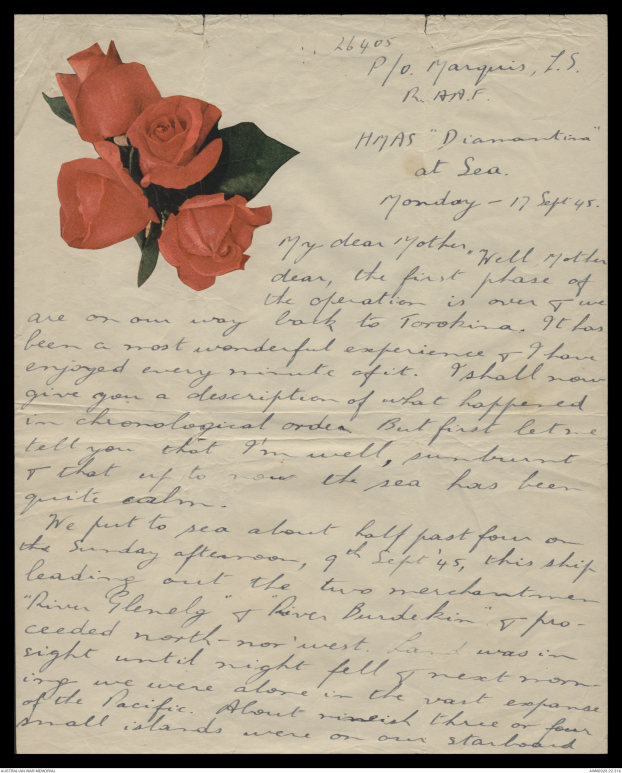
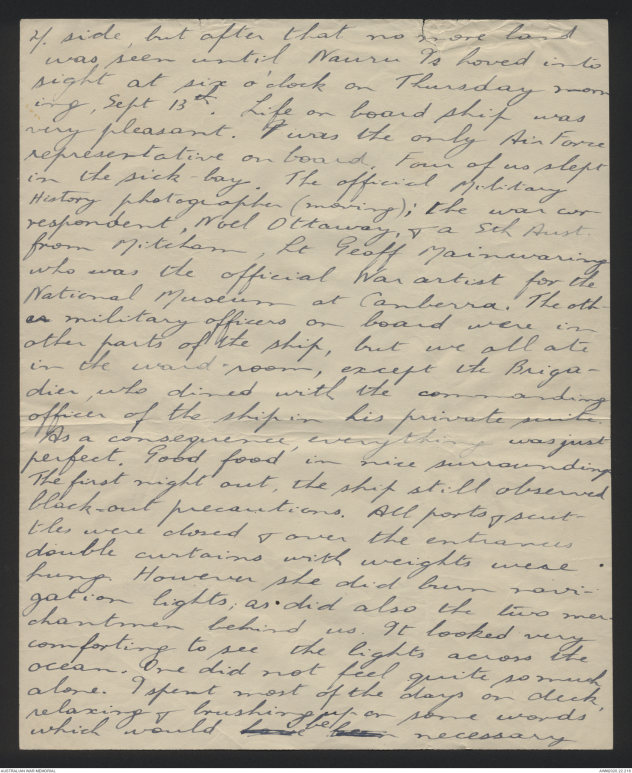
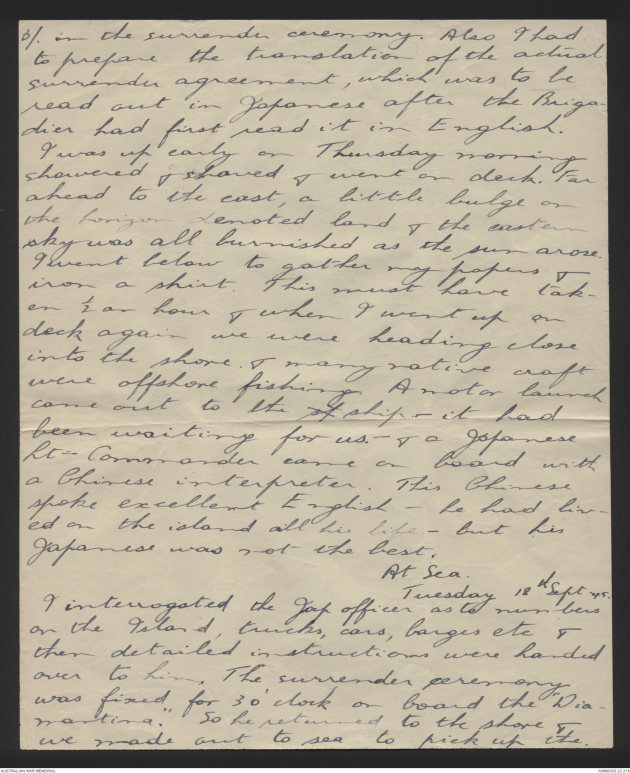
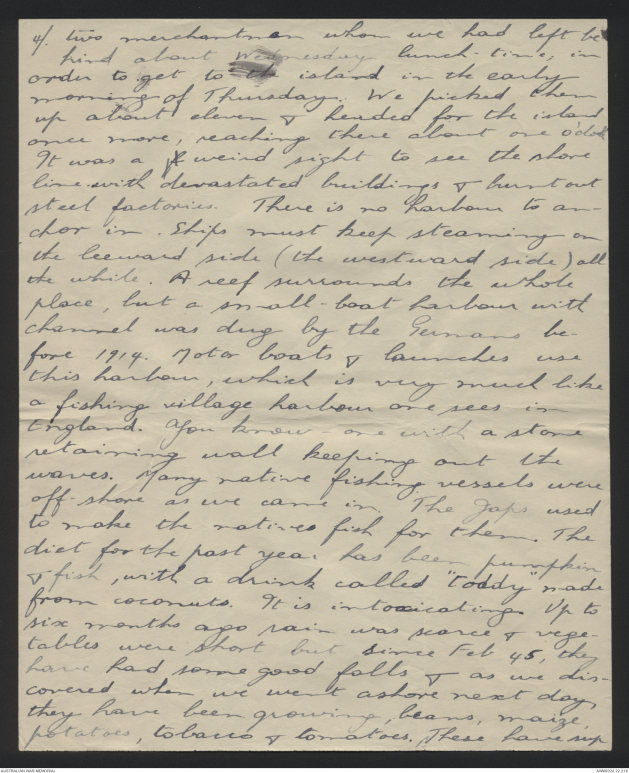
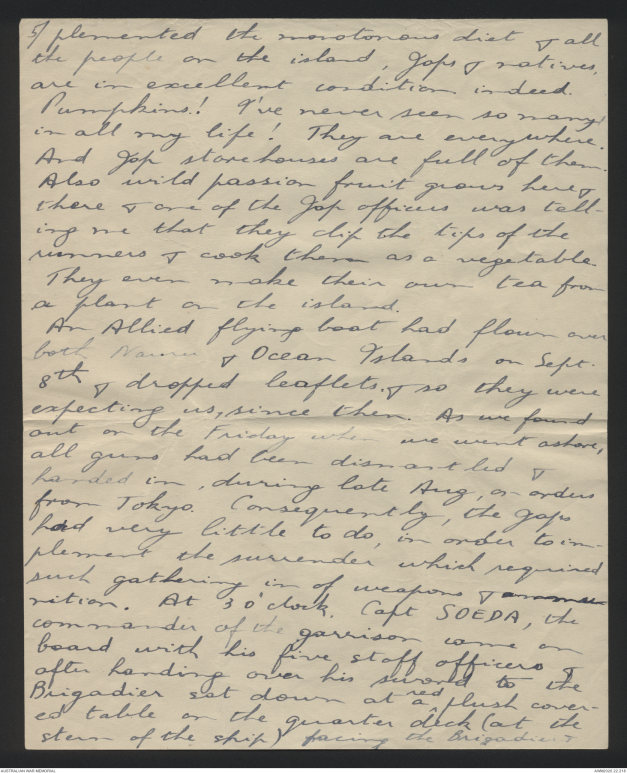
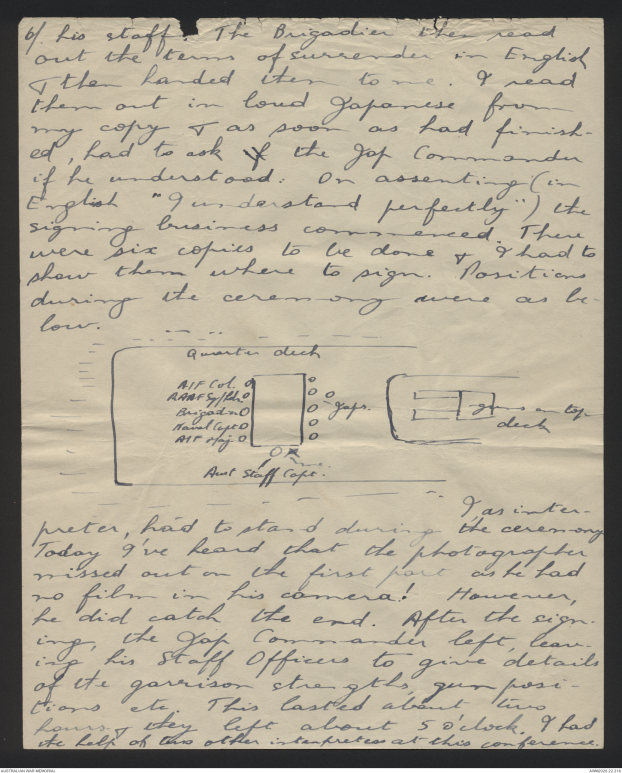
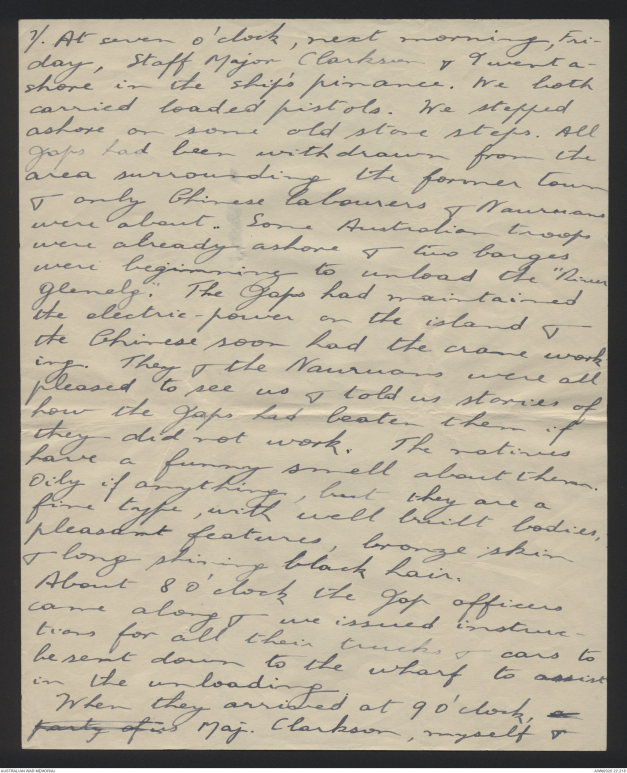
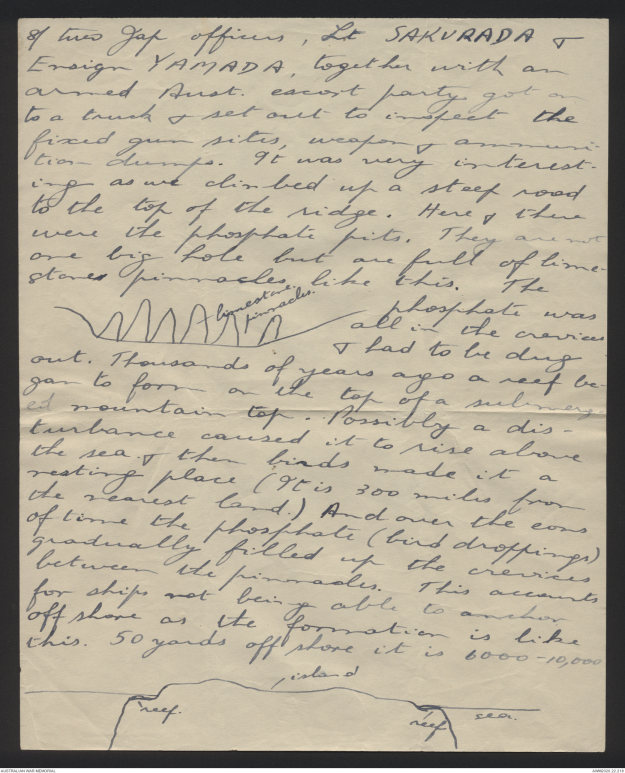
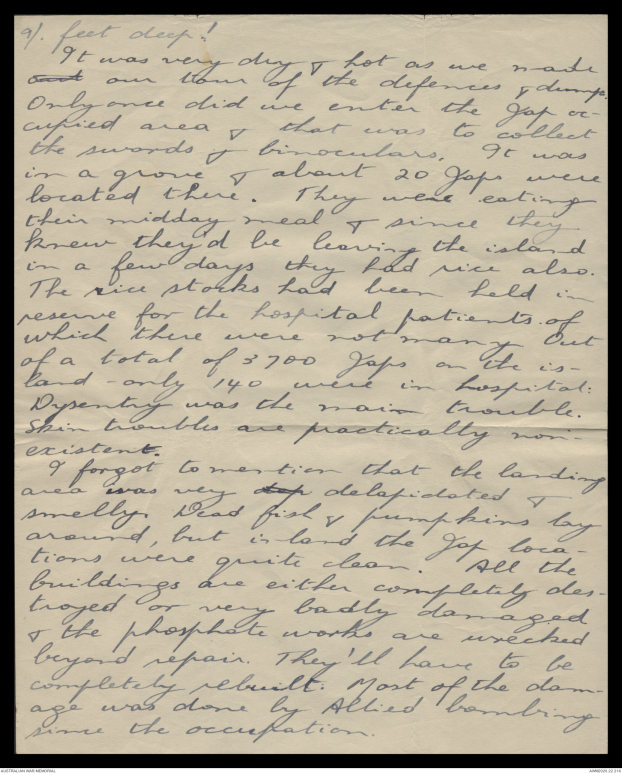
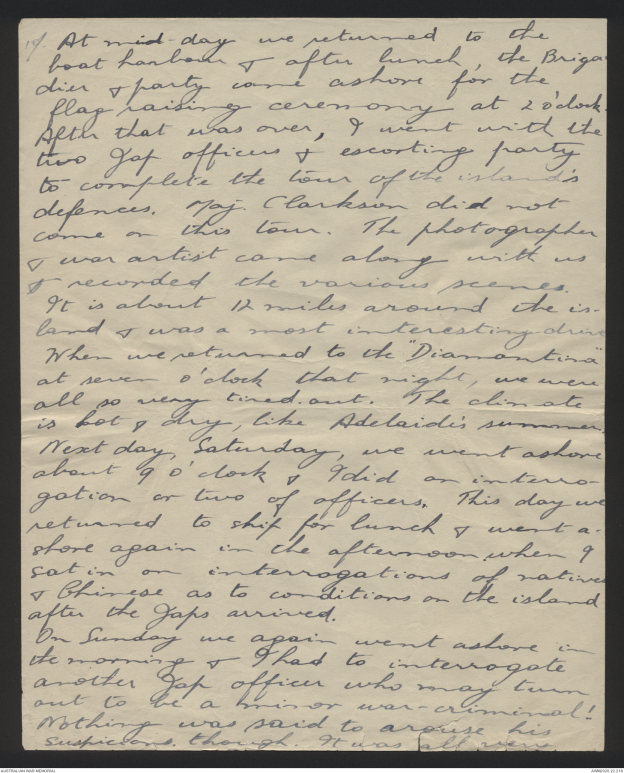
26405
P/O Marquis, L.S.
R.A.A.F.
HMAS "Diamantina"
at Sea.
Monday - 17 Sept 45.
My dear Mother,
Well Mother
dear, the first phase of
the operation is over & we
are on our way back to Torokina. it has
been a most wonderful experience & I have
enjoyed every minute of it. I shall now
give you a description of what happened
in chronological order. But first let me
tell you that I'm well, sunburnt
& that up to now the sea has been
quite calm.
We put to sea about half past four on
the Sunday afternoon, 9th Sept '45, this ship
leading out the two merchantmen
"River Glenelg" & "River Burdekin" & proceeded
north-nor'west. Land was in
sight until night fell & next morning
we were alone in the vast expanse
of the Pacific. About nineish three or four
small islands were on our starboard
2/. side, but after that no more land
was seen until Nauru Is hoved into
sight at six o'clock on Thursday morning,
Sept 13th. Life on board ship was
very pleasant. I was the only Air Force
representative on board. Four of us slept
in the sick-bay. The official Military
History photographer (moringo); the war
correspondent, Noel Ottaway, & a Sth Aust.
from Mitcham, Lt Geoff Mainwaring
who was the official War artist for the
National Museum at Canberra. The other
military officers on board were in
other parts of the ship, but we all ate
in the ward-room, except the Brigadier,
who dines with the commanding
officer of the ship in his private suite.
As a consequence, everything was just
perfect. Good food in nice surroundings.
The first night out, the ship still observed
black-out precautions. All ports & scuttles
were closed & over the entrances
double curtains with weights were
hung. However she did burn
navigation lights, as did also the two
merchantmen behind us. It looked very
comforting to see the lights across the
ocean. One did not feel quite so much
alone. I spent most of the days on deck,
relaxing & brushing up on some words
which would have ^be been necessary
3/. in the surrender ceremony. Also I had
to prepare the translation of the actual
surrender agreement, which was to be
read out in Japanese after the Brigadier
had first read it in English.
I was up early on Thursday morning
showered & shaved & went on deck. Far
ahead to the east, a little bulge on
the horizon denoted land & the easter
sky was all burnished as the sun arose.
I went below to gather my papers &
iron a shirt. This must have taken
1/2 an hour & when I went up on
deck again we were heading close
into the shore & many native craft
were offshore fishing. A motor launch
came out to the of ship - it had
been waiting for us - & a Japanese
Lt-Commander came on board with
a Chinese interpreter. This Chinese
spoke excellent English - he had
lived on the island all his life - but his
Japanese was not the best.
At Sea.
Tuesday 18th Sept '45.
I interrogated the Jap officer as to numbers
on the Islands, trucks, cars, barges etc &
then detailed instructions were handed
over to him. The surrender ceremony
was fixed for 3 o'clock on board the
"Diamantina". So he returned to the shore &
we made out to sea to pick up the
4/. two merchantmen whom we had left
behind about Wednesday lunch-time, in
order to get to the island in the early
morning of Thursday. We picked them
up about eleven & headed for the island
once more, reaching there about one o'clock.
It was a f weird sight to see the shore
line with devastated buildings & burnt out
steel factories. There is no harbour to
anchor in. Ships must keep steaming on
the leeward side (the westward side) all
the while. A reef surrounds the whole
place, but a small-boat harbour with
channel was dug by the Germans before
1914. Motor boats & launches use
this harbour, which is very much like
a fishing village harbour one sees in
England. You know - one with a stone
retaining wall keeping out the
waves. Many native fishing vessels were
off-shore as we came in. The Japs used
to make the natives fish for them. The
diet for the past year has been pumpkin
& fish, with a drink called "toddy" made
from coconuts. It is intoxicating. Up to
six months ago rain was scarce &
vegetables were short but since Feb 45, they
have had some good falls & as we
discovered when we went ashore next day,
they have been growing beans, maize,
potatoes, tobacco & tomatoes. These have
5/ supplemented the monotonous diet & all
the people on the island, Japs & natives,
are in excellent condition indeed.
Pumpkins! I've never seen so many
in all my life! They are everywhere.
And Jap storehouses are full of them.
Also wild passion fruit grows here &
there & one of the Jap officers was telling
me that they clip the tips of the
runners & cook them as a vegetable.
They even make their own tea from
a plant on the island.
An Allied flying boat had flown over
both Nauru & Ocean Islands on Sept.
8th & dropped leaflets & so they were
expecting us, since then. As we found
out on the Friday when we went ashore,
all guns had been dismantled &
handed in, during late Aug, on orders
from Tokyo. Consequently, the Japs
had very little to do, in order to implement
the surrender which required
such gathering in of weapons & ammunition.
At 3 o'clock, Capt SOEDA, the
commander of the garrison came on
board with the five staff officers &
after handing over his sword to the
Brigadier sat down at a ^red plush covered
table on the quarter deck (at the
stairs of the ship) facing the Brigadier &
6/. his staff. The Brigadier then read
out the terms of surrender in English
& then handed them to me. I read
them out in loud Japanese from
my copy & as soon as had finished,
had to ask if the Jap Commander
if he understood. On assenting (in
English "I understand perfectly") the
signing business commenced. There
were six copies to be done & I had to
show them where to sign. Positions
during the ceremony were as below.
[Diagram - Refer to original document]
I, as interpreter,
had to stand during the ceremony.
Today I've heard that the photographer
missed out on the first part as he had
no film in his camera! However,
he did catch the end. After the signing,
the Jap Commander left, leaving
his Staff Officers to give details
of the garrison strengths, gun positions
etc. This lasted about two
hours & they left about 5 o'clock. I had
the help of this other interpreter at this conference.
7/. At seven o'clock, next morning, Friday,
Staff Major Clarkson & I went ashore
in the ship's pinance. We both
carried loaded pistols. We stepped
ashore on some old stone steps. All
Japs had been withdrawn from the
area surrounding the former town
& only Chinese labourers & Nauruans
were about. Some Australian troops
were already ashore & two barges
were beginning to unload the "River
Glenelg". The Japs had maintained
the electric-power on the island &
the Chinese soon had the crane working.
They & the Nauruans were all
pleased to see us & told us stories of
how the Japs had beaten them if
they did not work. The natives
have a funny smell about them.
Oily if anything, but they are a
fine type, with well built bodies,
& long shining black hair.
About 8 o'clock the Jap officers
came along & we issued instructions
for all their trucks & cars to
be sent down to the wharf to assist
in the unloading.
When they arrived at 9 o'clock, a
part of us Maj. Clarkson, myself &
8/ two Jap officers, Lt SAKURADA &
Ensign YAMADA, together with an
armed Aust. escort party got on
to a truck & set out to inspect the
fixed fun sites, weapon & ammunition
dumps. It was very interesting
as we climbed up a steep road
to the top of the ridge. Here & there
were the phosphate pits. They are not
one big hole but are full of limestones
pinnacles like this. The
[Diagram - refer to original document]
phosphate was
all in the crevices
& had to be dug
out. Thousands of years ago a reef
began to form on the top of a submerged
mountain top. Possibly a
disturbance caused it to rise above
the sea & then birds made it a
resting place (It is 300 miles from
the nearest land.) And over the eons
of time the phosphate (bird droppings)
gradually filled up the crevices
between the pinnacles. This accounts
for ships not being able to anchor
off shore as the formation is like
this. 50 yards off shore it is 6000-10,000
[Diagram - refer to original document]
9/. feet deep!
It was very dry & hot as we made
out our tour of the defences & dumps.
Only once did we enter the Jap
occupied area & that was to collect
the swords & binoculars. It was
in a grove & about 20 Japs were
located there. They were eating
their midday meal & since they
knew they'd be leaving the island
in a few days they had fice also.
The rice stocks had been held in
reserve for the hospital patients of
which there were not many. Out
of a total of 3700 Japs on the island
-only 140 were in hospital.
Dysentry was the main trouble.
Skin troubles are practically
non-existent.
I forgot to mention that the landing
area was very dep delapidated &
smelly. Dead fish & pumpkins lay
around, but in land the Jap locations
were quite clean. All the
buildings are either completely
destroyed or very badly damaged
& the phosphate works are wrecked
beyond repair. They'll have to be
completely rebuilt. Most of the damage
was done by Allied bombings
since the occupation.
10/. At mid-day we returned to the
boat harbour & after lunch, the Brigadier
& party came ashore for the
flag raising ceremony at 2 o'clock.
After that was over, I went with the
two Jap officers & escorting party
to complete the tour of the island's
defences. Maj. Clarkson did not
come on this tour. The photographer
& war artist came along with us
& recorded the various scenes.
It is about 12 miles around the island
& was a most interesting drive.
When we returned to the "Diamantina"
at seven o'clock that night, we were
all so very tired out. The climate
is hot & dry, like Adelaide's summer.
Next day, Saturday, we went ashore
about 9 o'clock & I did an interrogation
on two of officers. This day we
returned to ship for lunch & went
ashore again in the afternoon when I
sat in on interrogations of native
& Chinese as to conditions on the island
after the Japs arrived.
On Sunday we again went ashore in
the morning & I had to interrogate
another Jap officer who may turn
out to be a minor war-criminal!
Nothing was said to arouse his
suspicions though. It was all very
 CMA
CMAThis transcription item is now locked to you for editing. To release the lock either Save your changes or Cancel.
This lock will be automatically released after 60 minutes of inactivity.